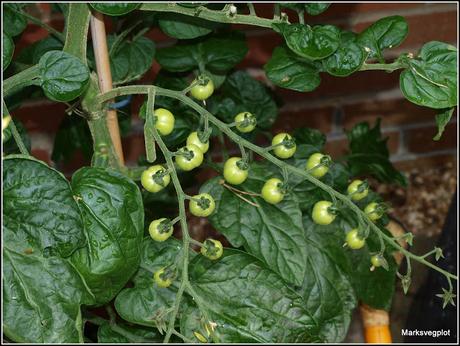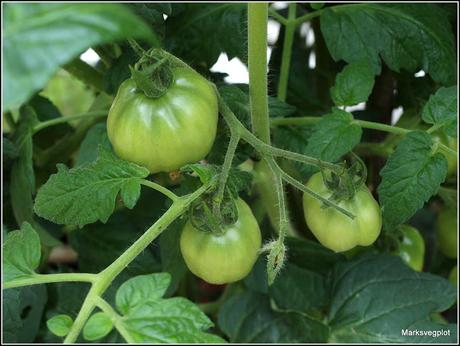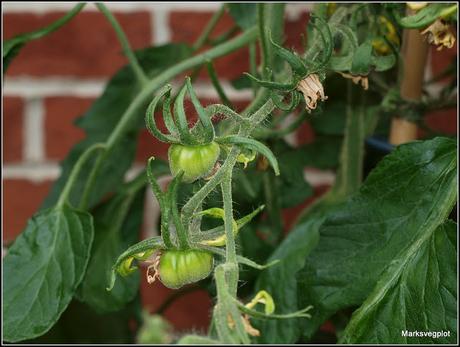Despite some early signs of the old weedkiller contamination in their compost, the tomato plants have done well so far, and have mostly grown big and strong. As long as the blight stays away, I can look forward to a good harvest. I suspect that blight WILL appear at some stage, so (as always) it is a race against time.
The first variety to produce ripe fruit will almost certainly be Maskotka. I have six plants of this one, and they are covered in fruits, with more forming every day.

Maskotka
Another early one will be Losetto, a variety that is alleged to have strong blight-resistance so therefore very welcome in my garden. It doesn't seem to be quite as vigorous as Maskotka, but it certainly has no shortage of fruits.

Losetto
Also in the cherry-tomato category, I have Sweet Aperitif, a red one, and Sungold, a golden-yellow one.

Sweet Aperitif

Sungold
The medium-sized varieties are represented by Ailsa Craig, Ferline and the bush-type Grushkova

Ailsa Craig

Ferline

Grushkova
The big beefsteak varieties are always the slowest to develop and set fruit, making them very vulnerable to blight, which is a big pity since I think they are often the best in terms of flavor and character.
This is the craggy Costoluto Fiorentino, already sporting a clutch of its characteristically deeply-ribbed fruits. So far only this one truss has set, but hopefully more will follow.

Costoluto Fiorentino
Fishlake Oxheart has only just begun setting fruit. It has an enormous number of flowers, and I think I will have to prune most of them off in order to make the plant concentrate on ripening just a few fruits. I have tried growing this variety twice before, but never managed to get any ripe fruit before the plant succumbed to blight. Maybe this year it will be "Third time lucky"?

Fishlake Oxheart
In the beefsteak or Very Large category I also have Cherokee Purple (purple), Vintage Wine (red), and Ananas (orange/yellow), but none of these have any fruits yet.
The last one I want to show off today is Marmande, a well-known traditional variety. For me this is the archetypical Mediterranean tomato - big, rugged and flavourful.

Marmande
I want to show you a second photo of this one, to illustrate something I do to my plants once the fruits begin to swell. I cut off quite a few of the leaves, in order to expose the fruits to more sunlight, which I believe helps them to ripen more quickly. Compare the previous photo (before) with this next one (after).

Marmande
In a similar vein, I also want to mention that when my tomato plants reach the tops of their canes I pinch out their growing-points. This stops them growing any taller, and makes them put their energy into the fruit, which ripen more quickly. I generally find that by the time the plants reach this stage they have produced at least 3 trusses of fruit, sometimes 5, but more usually 4. In my opinion it is better to get a modest amount of good ripe fruit than to hold out for a bigger a crop and risk losing everything to blight.
Since I seem to have strayed onto the subject of maintenance now, I feel I should perhaps make a couple more points. Firstly, don't forget that tomato plants need a lot of water, and they need a steady supply. Plants in containers are particularly susceptible to drying out. Despite my constant efforts to keep my plants evenly hydrated, one of them (Orange Banana) has developed some Blossom End Rot, which is reckoned to be caused by inability to absorb the right amount of calcium - in turn caused by insufficient or erratic watering. Here's a photo of an affected fruit:

Orange Banana - affected by Blossom End Rot
I think it is also important to feed container-grown tomato plants, because their compost will most likely not contain enough nutrients to keep the plant going until maturity. I feed mine with "Tomorite", once a week after fruits begin to set.
Since the tomato plants are growing vigorously at present, they need tying-in to their supports every few days. The recent combination of sunshine and rain has made mine grow about an inch a day.

Tomato plant tied-in to its cane support
Last but not least, I should perhaps remind you to keep removing the sideshoots of cordon-grown (indeterminate) tomato plants, to keep them growing straight and slim, but to avoid doing this with the bush (determinate) varieties which you want to remain "bushy" like this example of Losetto:

Losetto
Well that's my "words of wisdom" on tomatoes for now. Hopefully within a week or two I will be able to show off some ripe fruit!
